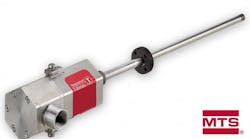MTS Sensors, a division of MTS Systems Corp., announced that its Temposonics T-Series sensors are now certified to NEC and CEC standards 500, 505, and 506. Both NEC and CEC certifications are used in U.S. and Canada to ensure operation of equipment in potentially hazardous conditions. The T-Series linear-position sensors, which already carry the ATEX and IECEx approvals used by other countries, are ATEX, IECEx, NEC, and CEC hazardous-area certified for use in Class I, II, and III in Divisions 1, and 2, for Groups A through G, and Zone 0/1, 21 and 22.
The T-Series is available in standard and SIL2 versions, which follow the Safety Integrity Level standard IEC 61508. It caters to the growing demand for hazardous-area and functional-safety solutions sought by engineers in the power-generation, oil-processing, and chemical-processing industries.
By integrating the company’s proprietary Temposonics magnetostrictive technology, the sensors feature non-contact position-measuring capabilities that ultimately eliminate moving parts for a longer lifespan and minimization of maintenance, plus there’s no need for recalibration. The sensors are resilient to vibrations, shock, and extreme pressures.

